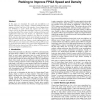Free Online Productivity Tools
i2Speak
i2Symbol
i2OCR
iTex2Img
iWeb2Print
iWeb2Shot
i2Type
iPdf2Split
iPdf2Merge
i2Bopomofo
i2Arabic
i2Style
i2Image
i2PDF
iLatex2Rtf
Sci2ools
FPGA
1999
ACM
1999
ACM
Using Cluster-Based Logic Blocks and Timing-Driven Packing to Improve FPGA Speed and Density
In this paper, we investigate the speed and area-efficiency of FPGAs employing “logic clusters” containing multiple LUTs and registers as their logic block. We introduce a new, timing-driven tool (T-VPack) to “pack” LUTs and registers into these logic clusters, and we show that this algorithm is superior to an existing packing algorithm. Then, using a realistic routing architecture and sophisticated delay and area models, we empirically evaluate FPGAs composed of clusters ranging in size from one to twenty LUTs, and show that clusters of size seven through ten provide the best area-delay trade-off. Compared to circuits implemented in an FPGA composed of size one clusters, circuits implemented in an FPGA with size seven clusters have 30% less delay (a 43% increase in speed) and require 8% less area, and circuits implemented in an FPGA with size ten clusters have 34% less delay (a 52% increase in speed), and require no additional area.
| Added | 04 Aug 2010 |
| Updated | 04 Aug 2010 |
| Type | Conference |
| Year | 1999 |
| Where | FPGA |
| Authors | Alexander Marquardt, Vaughn Betz, Jonathan Rose |
Comments (0)

